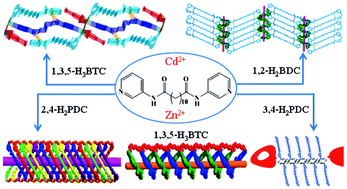Reactions of the flexible N,N′-di(3-pyridyl)dodecanediamide (L) with Zn(II) and Cd(II) metal salts in the presence of different polycarboxylic acids under hydrothermal conditions afforded five new coordination polymers, [Zn(2,4-PDC)(L)(H2O)]∞ (2,4-H2PDC = 2,4-pyridinedicarboxylic acid), 1, {[Zn(1,3,5-HBTC)(L)]·2H2O}∞ (1,3,5-H3BTC = 1,3,5-benzenetricarboxylic acid), 2, {[Zn(3,4-PDC)(L)]·0.5L}∞ (3,4-H2PDC = 3,4-pyridinedicarboxylic acid), 3, {[Cd(1,2-BDC)(L)(H2O)]·0.5L}∞ (1,2-H2BDC = 1,2-benzenedicarboxylic acid), 4, and {[Cd(1,3,5-HBTC)(L)1.5]·2H2O}∞, 5, which have been structurally characterized by X-ray crystallography. Complexes 1 and 2 manifest quintuple and double helices formed by zinc ions and L ligands, which are supported by 2,4-PDC2− and 1,3,5-HBTC2− anions, respectively, to construct the rare single-walled metal–organic nanotubes. Complex 3 shows 1D fish-bone chains and complexes 4 and 5 display 2D pleated grids with helical and looped carboxylate chains, respectively, supported by the L ligands. Complexes 1–3 represent a unique example of the polycarboxylate ligands showing a significant effect on folding and unfolding of the Zn(II) helical coordination polymers, and they are also important in determining the number of helices. The L ligands in 1, 2 and 4 adopt a bidentate bonding mode, and a unique monodentate bonding mode for the dipyridyl amide ligand is found in 3 and 5, resulting in various types of ligand conformations.


 Please wait while we load your content...
Please wait while we load your content...